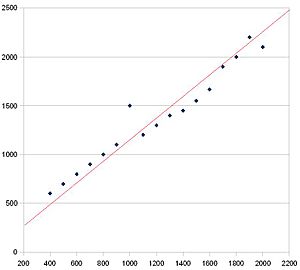Correlation facts for kids
In statistics and probability theory, correlation is a way to indicate how closely related two sets of data are.
But just because two things are connected doesn't always mean one causes the other. Sometimes, a third hidden factor might be involved!
Correlation can go in two main directions: positive or negative. If it's positive, both things tend to increase or decrease together. If it's negative, one thing tends to increase while the other decreases.
Many different ways are used to measure correlation. For example, on a scatter graph, people draw a line of best fit to show the direction of the correlation.
Contents
What is Correlation?
We use words like strong and weak to describe how powerful a correlation is. If there is a strong correlation, the data points on a graph are very close together. If it's weak, the points are spread far apart.
There are also ways to use numbers to show how strong a correlation is. These measurements are called correlation coefficients.
Measuring Correlation
One common way to measure this is called the Pearson correlation coefficient. It gives you a number between -1 and 1.
- If the number is close to 1 or -1, it means there's a strong connection.
- If the number is close to 0, there's hardly any connection at all.
Another type of measurement is called Spearman's rank correlation coefficient.
Correlation vs. Causation
It's very important to remember that just because two things are correlated (connected) doesn't mean one causes the other. This is called causation. There might be something else at play that connects them both.
Ice Cream and Sharks: An Example
Imagine this: On hot days, more people buy ice cream. Also, on hot days, more people go to the beach, and sadly, sometimes there are more shark attacks.
So, there's a correlation between ice cream sales and shark attacks. They both go up when the temperature rises. But buying more ice cream doesn't cause more shark attacks! The hot weather is the hidden factor that causes both.
Why This Matters
Because correlation doesn't always mean causation, scientists and researchers try to test their ideas carefully. They create special situations where they only change one thing at a time to see what happens.
However, sometimes people like advertisers or news reporters might suggest that a correlation means one thing causes another. They might do this by mistake, or because they want to convince you of something. For example, a news report might say that people who eat a certain food often have a health problem, making it sound like the food causes the problem. But it could be due to something else entirely!
Related Topics
Images for kids
See also
 In Spanish: Correlación para niños
In Spanish: Correlación para niños



